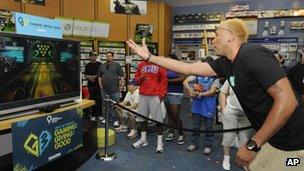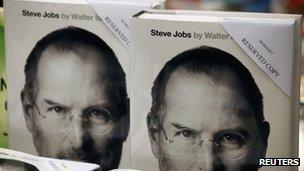Apple and Microsoft file patents for touchless controls
- Published

Microsoft's Kinect gaming system uses gesture-controlled technology
Apple and Microsoft are involved in a new patent race over touchless gesture-controls.
Recently released patent filings reveal new ways to control devices that do not involve physical contact.
Microsoft describes waving one's hands to "draw" three-dimensional objects on a computer, while Apple's designs involve allowing users to "throw" content from one device to another.
Securing patent rights allows the firms to claim ownership of the technologies.
They could then prevent others from using the same gesture controls, or charge them a licence.
The two technology firms are not the only ones exploring the area. Less well known companies, including Qualcomm and Extreme Reality 3D, have also acted to secure touchless control patent rights.
"It's interesting that so many companies are actually investing some very serious time and money into it," said Chris Green, a technology analyst at Davies Murphy Group.
"But the jury is still out on whether this whole waving-your-hands-in-the-air will have a long term future outside computer games, and it's still very much a work in progress."
'Throwing' video
The patent applications have been made public by the US Patent and Trademark Office.
Apple's filing, external, entitled "Real Time Video Process Control Using Gestures", describes controlling images on a device, such as an iPhone, without touching it, and the ability to transfer the pictures to one of the firm's other products using contact-free hand movements.
It suggests infrared, optical and other sensors would be used to detect the movements.
One use could be to transfer a video from a mobile phone by "flicking" it to a television.
"Say you're browsing a TV app on your phone and you found a programme you wanted to record, you could literally - just with a wave - take that programme and throw it to the other device using a gesture rather than using a Bluetooth or cable connection," said Mr Green.
Apple TV

Steve Job's biography suggests he had been working on a new Apple TV project
The patent application's release coincides with renewed speculation about Apple branded television sets.
The firm's former chief executive, Steve Jobs, appears to have hinted at the prospect to his biographer.
Walter Issacson wrote: "He very much wanted to do for television sets what he had done for computers, music players, and phones: make them simple and elegant".
Mr Isaacson quoted Mr Jobs as saying: "It will have the simplest user interface you could imagine. I finally cracked it."
The book was published following Mr Jobs' death, earlier this month.
Business applications
Microsoft has already put touchless gesture technology into practice with the popular Kinect motion sensing device for its Xbox games console.
"Microsoft's Kinect system has been widely praised for its accuracy and clarity, and even university research departments are using the Kinect devices, hacking them and using them for their projects," said Mr Green.
"But it is still fairly large, and if you'd like to apply it to a smartphone, you'd need to compress the Kinect down into something the size of your thumb."
Microsoft's recent filing details potential business applications for the technology.
It says it would be possible to make a gesture near a device's surface to "draw" and manipulate virtual 3D objects.
One possible use would be for someone giving a presentation to draw a square in the air and then have it appear behind them on a screen or mid-air from a 3D projector.
"You no longer have to use a mouse to draw a shape - you can just wave your hands in the air and it'll appear," Mr Green explained.
"That aspect potentially has some enterprise applications in terms of computer-aided design.... but it's still very expensive."
- Published26 October 2011
- Published23 October 2011